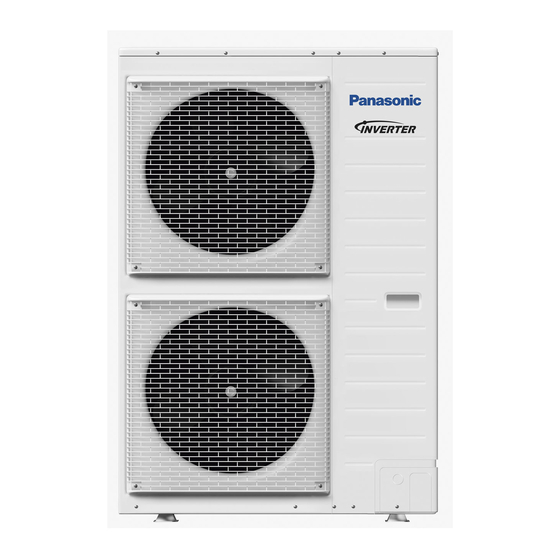Summarization of Contents
General Information
About this manual
Describes the manual's scope and structure, covering product description, planning, and installation.
Products covered
Lists the Aquarea heat pump systems covered in this manual: Compact, Split, and Hydro-modules.
Intended use
Explains the intended application of Aquarea heat pumps for heating and hot water provision.
Target groups
Identifies the target audience as specialist planning and installation operations.
Safety Notices
General Safety Notices for preventing electric shocks and other hazards to health
Provides critical safety guidelines regarding electrical hazards and health risks during installation.
General Safety Notices relating to preventing material damage
Outlines safety measures to prevent damage to devices from incorrect coolant or other factors.
General further information
Offers recommendations and additional information for installation, including local regulations.
Product Description
4.1 Operating Principle
Explains the basic functioning of an air-to-water heat pump and its circulation process.
4.2 Heat Source
Describes ambient air as the heat source, its availability, and considerations for planning.
4.3 Heat pump
Details the three Panasonic heat pump series (LT, T-CAP, HT) and their characteristics.
4.4 Heat use
Covers the applications for heating, hot water preparation, and cooling.
4.5 Model types
Explains the difference between split systems and compact systems.
4.6 Functions and technical data
Provides detailed features, technical data, and specifications for different system types.
4.7 Control
Describes the operating unit and its functions for controlling the heat pump system.
4.8 Accessories
Lists and describes available accessories such as hot water tanks and tanks.
Planning the Heat Pump System
5.1 Cooling technique and performance criteria
Covers performance calculations, outside temperatures, and heating loads for system design.
5.2 Installation criteria
Details criteria for installing split and compact systems, including acoustics and space requirements.
5.3 Hydraulics
Explains hydraulic integration, discharge head, pipe network resistance, and balancing.
5.4 Electricals
Covers electrical connections, power sources, and mains connection requirements.
5.5 Heating and cooling capacity depending on water inflow and outside temperature
Presents performance data tables correlating capacity with water inflow and outside temperatures.
5.6 Examples of use
Illustrates various system configurations and application possibilities of Aquarea heat pumps.
Installation Guide
6.1 Safety Notices for installation
Highlights critical safety instructions to be followed before and during the installation process.
6.2 Preparing for installation
Details essential requirements and checks to be performed before starting the installation work.
6.3 Creating a hole in the wall
Provides instructions for making wall holes, including slope and grommet usage.
6.4 Setting up devices
Guides on properly positioning and installing indoor, outdoor, and compact devices.
6.5 Opening devices
Explains how to safely open and re-close covers for maintenance access on various units.
6.6 Connecting the cooling circuit
Details the procedures for connecting the refrigerant pipelines for the cooling circuit.
6.7 Connecting the heating circuit
Covers the connection of water pipelines for the heating circuit and outflow hoses.
6.8 Connecting the electrical wiring
Provides instructions and safety precautions for making all electrical connections.
6.9 Starting up the system
Outlines the steps for commissioning the heat pump system, including evacuation, filling, and test runs.
Maintenance Procedures
7.1 Checking of the water pressure
Explains how to check and maintain the correct water pressure in the system.
7.2 Checking of the pressure relief valve
Details the procedure for checking the functionality of the pressure relief valve.
7.3 Conducting visual checks on the PCBs and terminals
Guides on performing visual inspections of electronic components and connections for defects.
7.4 Cleaning of the dirt catchers
Provides instructions for cleaning the dirt catchers to ensure optimal system performance.
7.5 Checking of the FI protection switch
Explains how to test the residual current device (FI protection switch) for proper operation.
7.6 Checking of the quick vent valve and venting the system
Describes how to check and vent air from the heating system using the quick vent valve.
7.7 Resetting the thermostatic overload protection
Details the steps to reset the thermostatic overload protection if it has been triggered.
7.8 Carrying out maintenance work on the cooling circuit
Outlines procedures for maintenance work on the cooling circuit, including coolant handling.
Appendix and Troubleshooting
8.1 Extract from the operating instructions (H-Generation)
Provides an extract from the operating instructions for the H-Generation, covering keys and display of the unit.


















Need help?
Do you have a question about the Aquarea WH-SHF09F3E5 and is the answer not in the manual?
Questions and answers